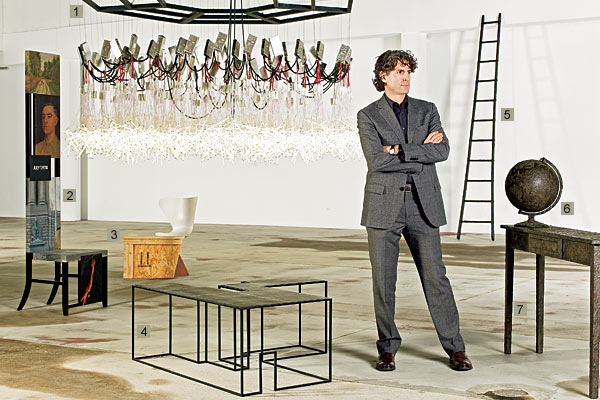
(1) Fractal Cloud chandelier, exposed wires with fluorescent tubes, by Arik Levy, 2008, price available upon request. (2) Biography chair, reproductions of oil paintings applied to wood and lacquered, from the Ultimate Art Furniture collection by Constantin and Laurene Leon Boym, 2006, $20,000. (3) Tagliata Arne chair, plywood crate and vintage Arne Jacobsen chair, by Martino Gamper, 2008, $8,500. (4) Coffee Table No. 1, enameled brass and leather, by Ron Gilad, 2009, $14,000. (5, 6, 7) Ladder ($12,000), globe ($5,500), and wood hall table ($8,500) coated with mixed media for a bronze effect, from the Timeless Objects collection by Boym Partners, 2009
Since opening his auction house, Wright, in 2000, Richard Wright has put hundreds of prime specimens of 20th-century design on the block, from American post-war furniture to iconic Italian pieces to important examples of Mexican modernism. These still make up the cornerstone of his company, but recently Wright has turned his attention to the here and now. Over the past year he has commissioned works from Arik Levy and up-and-coming designer Ron Gilad and mounted exhibitions for them; this past fall he launched a spinoff business called Wright 21, more akin to a gallery or a contemporary-design incubator than the traditional auction-house model that has gained him world renown. We spoke to Wright about his new venture and about his hopes for nurturing a new generation of design talent.
When did you start to take a serious interest in contemporary design? Beginning about 2006, the industry as a whole started to move toward contemporary. When I launched my auction house, American post-war was the hottest, and contemporary design looked very similar to it. Now you can look back and the good things, by designers like Jasper Morrison, stand out. But if you were looking at the aggregate of what was coming out of Milan in 2000 and 2001, you’d see a lot of biomorphic-inspired stuff, stuff that was derivative. I can’t chart exactly when this started to change, but the scene has gotten incredibly vibrant now. We decided to enter it in 2008.
Why have you decided to commission and present this work as a gallery would, rather than put it up for auction? Some of the work designers like Hella Jongerius and Marcel Wanders produce is not instantly collectible. Pieces conceived as limited editions are designated as collectible from the start, and some prototypes are collectible, but a lot of it is not suited for the auction market. Auctions are really about one thing—price. As work becomes historically accepted, it starts to have a value that is understood widely. It’s very hard to take something that’s just been produced and dump it into auction. It’s very one-dimensional. It’s not about educating. It’s more about, Did it sell? Or, What did it sell for? Many of the newer designers would get creamed.
So by commissioning work of your own and selling it, you are becoming a mini-manufacturer yourself? Sort of. I think of myself more as a gallerist, developing a stable of designers. Part of what I think is exciting about Wright 21 and about design today is that there are new, smaller distribution channels available to designers. Herman Miller and Vitra need to sell thousands of one design. We need to sell one. We sold one lamp by Ron Gilad. There’s only one like it—but while he was designing it for us, the head of Flos saw it in his studio and commissioned a tabletop version for production. What I want people to understand is that when you buy work like this, you’re supporting the continuation of design. You’re supporting Ron and experimental creative design. That’s how designers expand what they’re allowed to do for Flos, Herman Miller, and all those places.
Are there other dealers operating on a micro-level like this? Friedman Benda and Murray Moss in New York. Hedge Gallery in San Francisco. There are very few people in this space.
Are you concerned that this new focus might take away from your auction business? I think it’s good for my auction business. The more deeply my brand can be associated with design, the better. Design doesn’t end. It basically began with the Industrial Revolution and still continues today. I want to represent the entire spectrum. And I think most people now like the sophistication of mixing contemporary and historical pieces. There’s something about the surface of an older item, the patina, all the stuff that accrues over time—it’s not just dirt. And contemporary design has this power that’s totally different. I like living with both.
CONTACT Wright 21, 1440 W. Hubbard St., 312-563-0020, wright21.com
Photograph: Andreas Larsson


